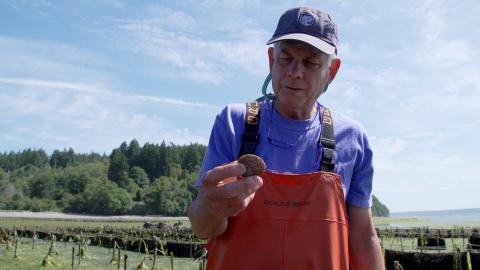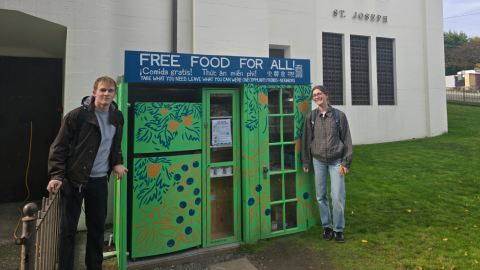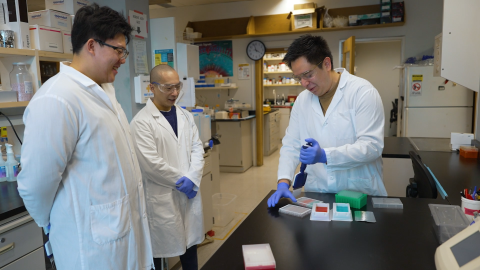The vast majority of earthquakes strike inside the Ring of Fire, a string of volcanoes and tectonic activity that wraps around the coastlines of the Pacific Ocean. But when an earthquake hits, the areas that experience the strongest shaking aren’t always the places that suffer the greatest damage.

Take the massive Chi-Chi earthquake, which caused extensive damage in Taiwan in the fall of 1999 and killed more than 2,400 people. The distribution of damage followed an uneven pattern: Deaths caused by the earthquake were concentrated not in densely populated city centers, but in those cities’ suburbs and outer fringes. A similar pattern has occurred following earthquakes in China, Chile and Nepal.
More than two decades later, researchers at the University of Washington have identified a hidden factor behind what they call ‘suburban syndrome’ — migration. Workers from small, rural communities often move into the outer edges of cities, which offer greater economic opportunities but often have low-quality housing that is likely to suffer greater damage during an earthquake. The risk grows even more when migrants come from low-income or tribal villages.
The findings, published in December in the journal Natural Hazards and Earth System Sciences, suggest that emergency management organizations should pay greater attention to migration and housing quality when developing disaster mitigation and response plans.
UW News spoke with lead author Tzu-Hsin Karen Chen, an assistant professor of environmental & occupational health sciences and of urban planning, to discuss ‘suburban syndrome,’ how migration can amplify disparities in a disaster’s impact, and what U.S. officials can learn from a Taiwanese disaster.
Your work on this study builds on an existing model that assesses earthquake risk by considering migration patterns and the movement of vulnerable populations. What does the existing model miss, and why is it important to fill those gaps?
Tzu-Hsin Karen Chen: This risk-assessment model has been used by many organizations internationally and in the United States. For example, FEMA uses a similar risk model to assess populations exposed to hazards, vulnerabilities and potential disaster impacts. They typically do a comprehensive risk assessment geographically within states and counties, identify areas with potential larger impacts, and then draft a preparedness plan.
.jpg)
In United States, temporary domestic migrants and undocumented immigrants don’t always officially register in government systems. One common reason is the fear of deportation or other legal repercussions. And so, when a government agency like FEMA allocates resources for disaster preparedness or recovery, relying on registered population data can lead to an underestimate of the support required in certain areas.
In Taiwan, our study case, many migrant workers moving from rural to urban areas don’t update their registered residence. They still have their registration back in their hometown, like in a tribal area. It just doesn’t make sense to re-register, because they might have multiple jobs within a single year in different places.
To minimize expenses, some workers look for the lowest possible rent, and their rental housing might not be officially registered either. Those could be informal housing structures, like a metal floor added on top of a concrete building, which don’t comply with safety regulations. The informality of this process can help lower their cost of living, but can also leave them more vulnerable to disasters.
How did you get started in this research?
TKC: I’ll share my personal story, but I also want to acknowledge my co-authors for their years of work in risk assessments. For me, it started back in 2010, when I volunteered in a tribal area of Taiwan teaching computer skills. This provided bigger lessons for me than anything I could’ve taught them. I learned how teenagers often move from their tribal areas downhill to nearby cities to take construction jobs during the off-crop seasons. Those jobs pay more than farm work, but they’re also very physically demanding and often lack worker protections like job security and health insurance. Seeing that put a seed in my mind.
When I was a master’s student, a team from the National Earthquake Center and Academia Sinica in Taiwan was working on a risk assessment of the Chi-Chi earthquake using the exposure, vulnerability and hazard framework. They had already published a fundamental risk assessment, and reached out to me to develop an extended study by incorporating spatial statistics. That collaboration eventually evolved into the study in this paper.
The COVID-19 pandemic also shaped this study. I came across news about how migrant workers were stuck in urban fringe areas of India. Because of the lockdown, they weren’t able to continue their work, and their crowded living conditions left them at even greater risk during the pandemic. I started to wonder: How can we shift from a pure statistical model to something more meaningful? How can we bring migration into the center of the discussion?
The final push came from colleagues’ work at the UW. I’ve noticed initiatives for undocumented students and research efforts around environmental justice and health equity. For example, my co-author Diana Ceballos’s research on migrant worker’s health was particularly motivating. We read and wrote back and forth to refine the framing and discussion in this paper.
At first glance, it seems obvious that greater migration would lead to higher fatalities in a given area, just because there are more people present when disaster strikes. Is that the primary driver, or are there other factors at play?
TKC: Logically, if there are more people, and the percentage of fatalities is equal, then there should be more people dying from a specific event. But we found it’s not just about population numbers. There are two additional factors: When migrant workers are from areas with lower incomes, or when they are from tribal areas, those factors significantly contribute to higher fatalities in the places they migrate to.
Our hypothesis is that it’s about housing safety. Migrant workers tend to move to cities, and when cities are more expensive, affluent workers might be able to secure housing that offers better protection against disasters. However, workers from tribal or low-income areas tend to settle in urban fringe zones where affordable housing options might not meet safety standards, making them more vulnerable to earthquakes.
Co-authors on this study include Diana Ceballos of the UW Department of Environmental & Occupational Health Sciences; Kuan-Hui Elaine Lin of National Taiwan Normal University, Thung-Hong Lin of Academia Sinica in Taiwan; and Gee-Yu Liu and Chin-Hsun Yeh of the National Center for Research on Earthquake Engineering in Taiwan.
For more information, contact Chen at kthchen@uw.edu.
Adapted from the full story here.




